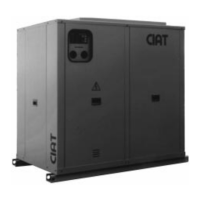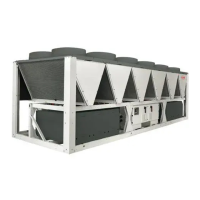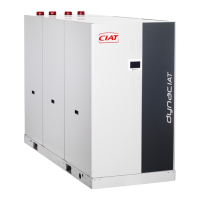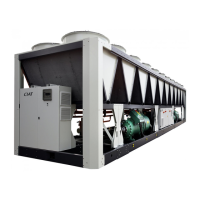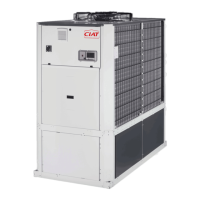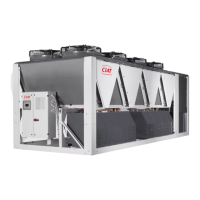(1) Les capacités en eau de l’installation
mentionnées dans les tableaux ci-dessus
sont des capacités disponibles pour l’installa-
tion en fonction du vase d’expansion monté
sur le groupe.
Le ballon tampon est déjà pris en compte.
Dans le cas où la capacité de l’installation est
supérieure, il faut rajouter un vase d’expan-
sion sur l’installation correspondant à la
capacité excédentaire.
(2) Les températures d’eau mentionnées
sont les températures pouvant être atteintes
machine à l’arrêt.
(1) The water capacity of the installation as
listed in the above charts is the capacity
available for the installation depending on the
expansion vessel fitted to the unit.
The buffer tank has already been taken into
account.
If the capacity of the installation is higher, an
expansion vessel must be added to the instal-
lation, corresponding to the excess capacity.
(2) The water temperatures listed are the
temperatures which can be attained with the
machine stopped.
(1) Das Wasserfassungsvermögen in der Tabelle
entspricht der verfügbaren Menge für die Einrichtung in
Abhängigkeit vom Ausdehnungsgefäß.
Der Pufferspeicher ist hierbei bereits eingerechnet.
Bei einem höheren Fassungsvermögen ist ein weiteres
Ausdehnungsgefäß für die zusätzliche Menge
einzubauen.
(2) Die angegebenen Wassertemperaturen gelten für
das ausgeschaltete Gerät.
LJAH 100 150 200 250 300 350 400 450 500 600
Ballon tampon (litres)
Buffer tank (litres) -
Pufferspeicher (Liter)
350
Vase d’expansion (litres)
Expansion vessel (litres) -
Ausdehnungsgefäß (Liter)
35
Pression de gonflage (bar)
Filling pressure (bar) -
Fülldruck (Bar)
1,5
Capacité maximum de l’installation en litres (1)
Maximum capacity of the installation in litres (1) -
Max. Fassungsvermögen in Litern (1)
Eau pure
Purewater
Reines Wasser
T° maxi eau 36 °C (2)
Max. water temp. 36 °C (2) -
Max. Wassertemp. 36°C (2)
2470
T° maxi eau 46 °C (2)
Max. water temp. 46 °C (2) -
Max. Wassertemp. 46°C (2)
1370
Eau glycolée
Glycolsolution
Glykolwasser
T° maxi eau 36 °C (2)
Max. water temp. 36 °C (2) -
Max. Wassertemp. 36°C (2)
1440
T° maxi eau 46 °C (2)
Max. water temp. 46 °C (2) -
Max. Wassertemp. 46°C (2)
810
Protection antigel par
eau glycolée
Si l’appareil LJA - LJAH est installé dans un
local non maintenu hors gel, il est impératif
d’utiliser un fluide caloporteur spécifique.
Le tableau ci-dessous indique les pourcen-
tages de glycol minimum à prévoir dans l’ins-
tallation en fonction du point de congélation.
Frost protection with glycol
solution
If the LJA or LJAH unit is installed in a loca-
tion not maintained above freezing, it is
essential to use a special refrigerant liquid.
The table below indicates the minimum glycol
percentages to be used according to the free-
zing point..
Frostschutz durch Glykolwasser
Wurde das Gerät LJA - LJAH ohne Frostschutz geliefert
ist obligatorisch ein besonderes Kältemittel zu
verwenden.
Die nachstehende Tabelle zeigt den Prozentsatz für
den Mindestanteil an Glykol an, der in Abhängigkeit von
dem zu erwartenden Frost zu verwenden ist.
Concentration
Concentration -
Konzentration
% 10 20 30 40
Mono éthylène glycol
Monoethylene glycol
-
Monoethylenglykol
°C 0 -3,8 -8,3 -14,5 -23,3
Mono propylène glycol
Monopropylene glycol
- M
onopropylenglykol
°C 0 -2,7 -6,5 -11,4 -20
ATTENTION : la concentration en glycol doit
protéger le fluide au moins 12 °C en dessous
de la température de sortie d’eau prévue à
l’évaporateur afin de permettre un réglage
correct du régulateur de pression mini d’éva-
porateur.
ATTENTION: The concentration in glycol will
has to protect the fluid at least 12°C below
the water outlet temperature fore casted at
the evaporator in order to allow a correct set-
ting of the evaporator minimum pressure
regulator.
Achtung: das Glykolkonzentrat muss die Flüssigkeit
um 12 °C grad unter Wasseraustrittstemperatur schüt-
zen damit bei minimaler Verdampfungstemperatur ein
Einfrieren des Verdampfers verhindert wird.
10
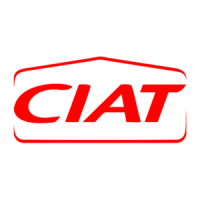
